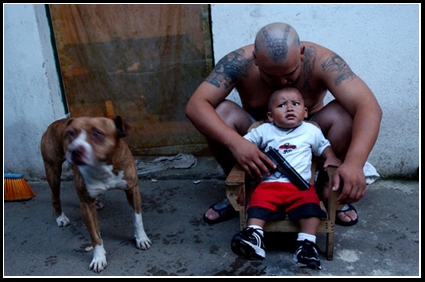The two principal Mara gangs in Guatemala, Mara Salvatrucha and Barrio 18, have been reorganizing themselves under more centralized leadership, presenting an increasing threat to the national security of this fragile Central American nation.
An investigation carried out by Mexico’s El Universal has looked at the changing nature of the Maras groups from disparate associations of street gangs affiliated to the same franchise, to increasingly organized transnational criminal syndicates.
The primary source of the investigation was Juan Pablo Rios, the coordinator of a specialized task force (Fuerza de Tarea Contra el Sicariato) set up by the Guatemalan Ministry of the Interior to face the growing Maras threat.
“They are groups organized in a very hierarchical manner, in which there is one person who gives orders, who makes the decisions,” said Rios.
The two Mara groups are made up of separate cliques (“clicas”), each with its own leader, known as a “ranflero.” Historically there was only sporadic contact between the cliques. However now in Guatemala, each of the main Mara groups has a centralized leadership structure. Mara Salvatrucha (MS-13) has the “Council of the Nine,” while Barrio 18 has the “Wheel of the Barrio.” The Wheel of the Barrio is believed to be made up of 16 of the most senior ranfleros, while Mara Salvatrucha’s Council of the Nine has now grown to 37 members, according to the Ministry of the Interior.
After ranfleros in the Mara hierarchy come the “llaveros,” who pass on orders and act as go-betweens for the top command and the cliques on the street. The next level is made up of the “sicarios” (assasins), and finally there are the “paros,” who are like Mara auxiliaries, helping the collection of extortion, movement of arms, gathering of intelligence, and recruitment.
Guatemalan authorities have also identified the top leaders of each Mara: Jorge Yahir De Leon Hernandez, alias “El Diabolico,” of MS-13, and Aldo Dupie Ochoa Mejia, alias “El Lobo,” of Barrio 18. Both men are in maximum security prisons.
That the Mara groups should be operating from jails is no surprise. The groups were first formed in US prisons during the 1980s. It is in prisons, not only in Guatemala, but also El Salvador and Honduras, that the Maras organize themselves, train up their members, and run their cliques and networks. Authorities estimate that there are now up to 8,000 maras in Guatemala.
Specialist networks have sprung up within the Mara organizations. Some are dedicated to running the finances, others to running assassination networks; there are cells that provide logistical support and then those representatives who liaise with lawyers, for whom there is an endless supply of work.
InSight Crime Analysis
It should come as no surprise that the Maras are organizing themselves. The gangs have long been under pressure throughout Central America thanks to the “iron fist” approach favored by many governments, often scooping up young men from the streets based on their tattoos alone, and throwing them into prison. The jails are the real administrative centers for the Maras, and prisons in Guatemala, El Salvador and Honduras suffer from chronic overcrowding and are usually run by the inmates.
Added to this, the negotiation of a gang truce in El Salvador, and the awakening of the Mara leadership there to the potential of their political power, was bound to have an impact. While there are no formal negotiations going on between the Maras and the Guatemalan government, in July 2012, the Barrio 18 boss, Aldo Dupie alias “The Wolf,” stated that they would be interested in such an opportunity.
There have also been allegations that the Maras are increasingly working alongside powerful transnational criminal groups like the Zetas. The attraction for the Zetas, one of Mexico’s most brutal cartels, to have access to a pool of hardened killers throughout Central America is obvious. They can eliminate rivals and guard drug shipments. The Maras are happy to take payment in drugs, which they then sell through their local distribution networks.
There are indications that the Maras are becoming involved in transnational crime, in terms of human smuggling and drug trafficking. This was inevitable, given the fact that the two principal Mara groups are transnational in nature, with presence in Guatemala, Honduras, El Salvador and Mexico, with links back into the United States.
The Maras have traditionally survived from street level extortion, local drug dealing, and robbery. However with their increasing sophistication and new involvement in transnational crime, it is clear they are broadening their structures to include money laundering, and using cliques not only within Guatemala but throughout Central America when needed.
The US Treasury Department has recognized the increasing sophistication of Mara Salvatrucha by placing financial sanctions on the gang, putting it in the same league as transnational criminal organizations like the Italian Camorra, the Zetas, and Yakuza of Japan. The Treasury designation also reveals that Mara groups in the US are not only in touch with the leadership in Central America, but channeling funds to them.
The days of being able to identify Mara members through their body art may be coming to an end. As they increase in sophistication, like all organized criminal groups, they will seek to become more clandestine in their activities. With up to 100,000 members scattered across Central America, Mexico, and the US, the Maras could present single greatest threat to regional security in Central America since the civil wars.

